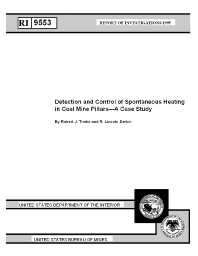Mining Publication: Detection and Control of Spontaneous Heating in Coal Mine Pillars-A Case Study
Original creation date: January 1995
This U.S. Bureau of Mines study examined spontaneous heating episodes in coal mine pillars in an active underground coal mine. The information obtained from these incidents was then analyzed to learn which sampling methods provided the earliest indication of pillar heating. The objective of this study was to discover if the location of future events of pillar spontaneous heating could be inferred from the available information. The spontaneous heating-prone area in this evaluation involved pillars located just inby the mine portals. Several detection methods were used to determine gas levels outside as well as inside the affected pillars. It was hoped that, by incorporating external and internal sampling methods into an organized program, locations undergoing spontaneous heating could be determined more readily. This study found that by drilling small-diameter boreholes into the pillars, then obtaining gas samples from the affected pillars, the ability to locate early spontaneous heating episodes was improved. However, the ability to accurately predict future spontaneous heating events remains in question.
Authors: RJ Timko, RL Derick
Report of Investigations - January 1995
NIOSHTIC2 Number: 20022927
U.S. Department of the Interior, Bureau of Mines, Report of Investigations 9553. NTIS stock number: PB95-236790, 1995 Jan :1-18
See Also
- Advance and Relieve Mining: A Method to Mitigate the Effects of High Horizontal Stress on the Mine Roof
- Benchmarking Longwall Dust Control Technology and Practices
- Cause of Floor Self-Heatings in an Underground Coal Mine
- Determining the Spatial Variability of Personal Sampler Inlet Locations
- Effects of Weak Bands on Pillar Stability in Stone Mines: Field Observations and Numerical Model Assessment
- The Limiting Oxygen Concentration and Flammability Limits of Gases and Gas Mixtures
- Pillar Design Issues for Underground Stone Mines
- Pillar Stability Issues Based on a Survey of Pillar Performance in Underground Limestone Mines
- Reconciling Longwall Gob Gas Reservoirs and Venthole Production Performances Using Multiple Rate Drawdown Well Test Analysis
- Rock Dusting Considerations in Underground Coal Mines
- Content source: National Institute for Occupational Safety and Health, Mining Program


 ShareCompartir
ShareCompartir
